Reference no: EM131737811
Managing Process Flows
Discussion Questions and Exercises
5.1 Explain in your own words the different types of flows in a process.
5.2 What is the relationship between WIP and the input and output rates over time?
5.3 A Burger King processes on average 1200 customers/day (over the course of 15 h). At any given time, 60 customers are in the store. Customers may be waiting to place an order, placing an order, waiting for the order to be ready, eating, and so on. What is the average time that a customer spends in the store?
5.4 A branch office of the University Federal Credit Union processes 3000 loan applica-tions per year. On the average, loan applications are processed in 2 weeks. Assuming 50 weeks/year, how many loan applications can be found in the various stages of processing within the bank at any given time?
5.5 In Exercise 5.3, it is mentioned that at any given time, one can find 60 customers in the store. How often can the manager of the store expect that the entire group of 60 customers would be entirely replaced?
5.6 The process of designing and implementing a website for commercial use can be described as follows. First, the customer and the web design team have an infor-mational meeting for half a business day. If the first meeting is successful, the cus-tomer and the web design team meet again for a full day to work on the storyboard of the site. If the first meeting is not successful, then the process is over, which means the customer will look for another web designer. After the storyboard is completed, the site design begins; immediately after that, the site is developed. The design of the site typically takes 10 business days. The development of the site requires 2 business days. While the site is being designed and developed, the contents are prepared. It takes 5 business days to complete an initial draft of the contents. After the initial draft is completed, a decision is made to have a marketing team review the initial draft. Experience shows that about 60% of the time the marketing review is needed and 40% of the time the final version of the contents is prepared without the marketing review. The marketing review requires 3 business days, and the preparation of the final version requires 4 business days. The contents are then put into the site. This activity is referred to as building. (Note that before the building can be done, the development of the site and the contents must be completed.) Building the site takes about 3 business days. After the site is built, a review activity is completed to check that all links and graphics are working correctly. The review activity typically is com¬pleted in 1 business day. The final activity is the approval of the site, which is done in half a business day. About 20% of the time, the sites are not approved. When a site is rejected, it is sent back to the building activity. When the site is approved, the design process is finished.
a. Draw a flowchart of this process.
b. Calculate the CT.
5.7 Consider the process flowchart in Figure 5.11. The estimated waiting time and pro-cessing time for each activity in the process are shown in Table 5.11. All times are given in minutes.
a. Calculate the average CT for this process.
b. Calculate the CT efficiency.
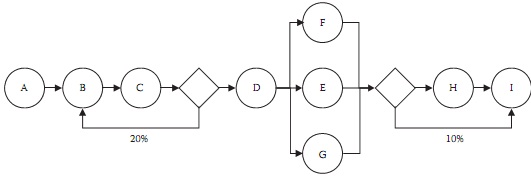
TABLE 5.11
Time Data for Exercise 5.7
|
Activity
|
Waiting Time
(Min)
|
Processing Time
(Min)
|
|
A
|
7
|
3
|
|
B
|
5
|
8
|
|
C
|
4
|
2
|
|
D
|
10
|
5
|
|
E
|
7
|
2
|
|
F
|
0
|
3
|
|
G
|
2
|
5
|
|
H
|
8
|
9
|
|
1
|
2
|
8
|
TABLE 5.12
Resource Assignments for Exercise 5.8
| Activity |
Resource Type |
| A |
R1 |
| B |
R2 |
| C |
R2 |
| D |
R2 |
| E |
R3 |
| F |
R3 |
| G |
R4 |
| H |
R4 |
| I |
R1 |
5.8 For the process in Exercise 5.7, assume that the resources in Table 5.12 are needed in each activity. Also assume that there are two units of R1, three units of R2, two units of R3, and two units of R4.
a. Calculate the theoretical process capacity and identify the bottleneck.
b. If the actual throughput has been observed to be 6 jobs/hour, what is the capacity utilization?
5.9 For the process flowchart in Figure 5.12, where the numbers between parentheses are the estimated activity times (in minutes), calculate the average CT.
5.10 Assume that the processing times (in minutes) for the activities in Exercise 5.9 are estimated as shown in Table 5.13. Calculate the CT efficiency.
5.11 Assume that four resource types are needed to perform the activities in the pro¬cess of Exercises 5.9 and 5.10. The resource type needed by each activity is shown in Table 5.14.
a. Considering that there are two units of resource 1, two units of resource 2, three units of resource 3, and three units of resource 4, calculate the capacity of the process.
b. If the actual throughput of the process is 2.5 jobs/h, what is the capacity utilization?

TABLE 5.13
Processing Times for Exercise 5.10
| Activity |
Processing Time (Min) |
| A |
13 |
| B |
2 |
| C |
15 |
| D |
13 |
| E |
20 |
| F |
28 |
| H |
25 |
| I |
11 |
| J |
15 |
| K |
12 |
| L |
5 |
| M |
5 |
| N |
11 |
TABLE 5.14
Resource Assignments for Exercise 5.11
Resource Activities
1 A, E, and G
2 B, D, and J
3 C,I,K,andNI
4 F, H, L, and N:
5.12 Three teams (T1, T2, and T3) work in the process depicted in Figure 5.13, where the numbers in each activity indicate processing times in minutes. Calculate the capacity utilization of the process assuming that the throughput is 1 job/h.
5.13 Consider the business process depicted in Figure 5.14 and the time values (in minutes) in Table 5.15. Use CT efficiency to compare this process with a redesigned version where the rework in activity G has been eliminated and activities D, E, and F have been merged into one with processing time of 10 min and zero waiting time.
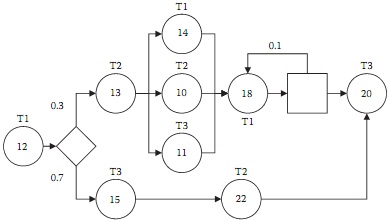
figure 5.13
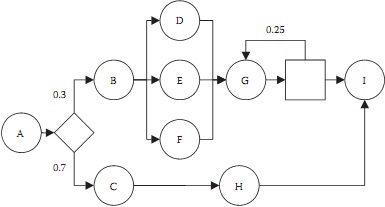
figure 5.14
5.14 Nine people work in the process depicted in Figure 5.15. The numbers next to each activity are processing times in minutes. Table 5.16 shows the assignment of workers to activities.
a. Calculate the capacity of the process in jobs per hour.
b. Management is considering adding one worker to the process, but this would increase the operational cost by $23/h. Management knows that increasing the process capac¬ity by 1 job/h adds $30/h to the bottom line. Based on this information, would you recommend adding a worker, and if so, with whom should the new person work?
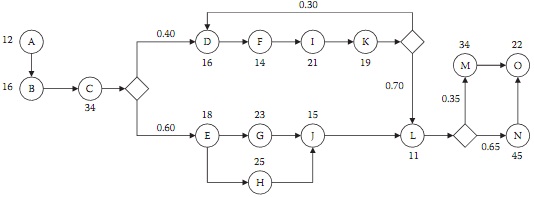
figure 5.15
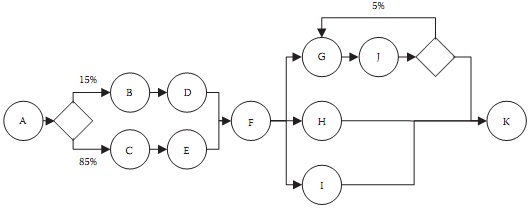
figure 5.16
5.15 A process management team has studied a process and has developed the flowchart in Figure 5.16. The team also has determined that the expected waiting and process¬ing times (in minutes) corresponding to each activity in the process are as shown in Table 5.17.
a. Calculate the average CT for this process.
b. Calculate the CT efficiency.
TABLE 5.17
Time Data for Exercise 5.15
|
Activity
|
Waiting Time
(Min)
|
Processing Time
(Min)
|
|
A
|
20
|
12
|
|
B
|
15
|
18
|
|
C
|
5
|
30
|
|
D
|
12
|
17
|
|
E
|
3
|
12
|
|
F
|
5
|
25
|
|
G
|
8
|
7
|
|
H
|
5
|
10
|
|
1
|
15
|
25
|
|
1
|
5
|
20
|
|
K
|
4
|
10
|

figure 5.17
5.16 A process-design team is analyzing the capacity of a process. The team has devel-oped the flowchart in Figure 5.17. The numbers between parentheses indicate the processing times in minutes, and the labels above or below each activity indicate the resource type (i.e., R1= resource 1). The process has one unit of resource R1, two units of resource R2, and three units of resource R3. Assume that a reworked job has the same chance to pass inspection as a regular job.
a. Calculate the theoretical process capacity and identify the bottleneck.
b. If the actual throughput rate of the process is 1 job/h, what is the capacity utilization?
5.17 Use the TOC and the data in Tables 5.18 and 5.19 to determine how many units of each job type should be completed per week in order to maximize profits. Consider that the availability is 5500 min for resource R1, 3000 min for resource R2, and 8000 min for resource R3.
5.18 An order fulfillment process has demand for three order types during the next 4 weeks, as shown in Table 5.20. The assignment of activities to workers and process¬ing time for each activity are shown in Table 5.21. All workers have 40 h/week available to work on this process. Use the TOC principles to find the number of orders of each type that should be processed to maximize total profit.
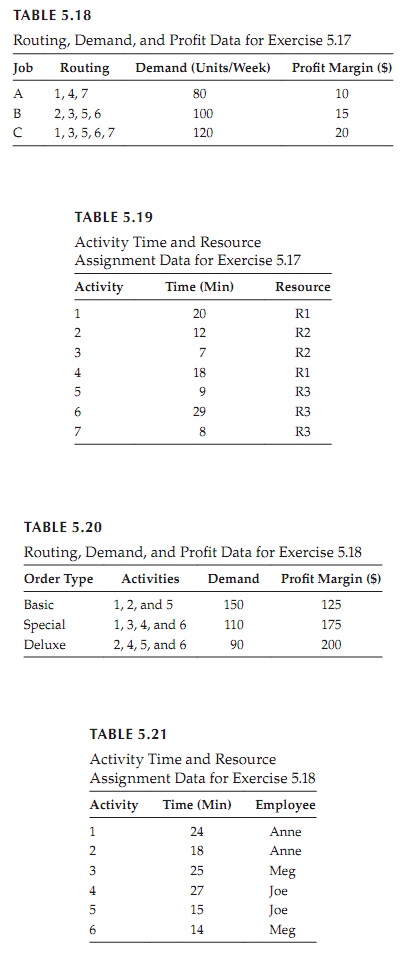
Textbook - BUSINESS PROCESS MODELING, SIMULATION AND DESIGN - SECOND EDITION by Manuel Laguna and Johan Marklund